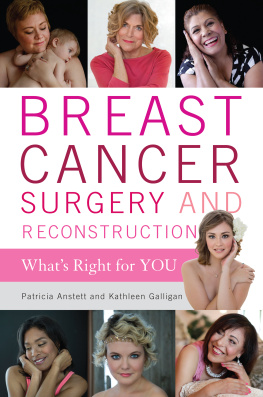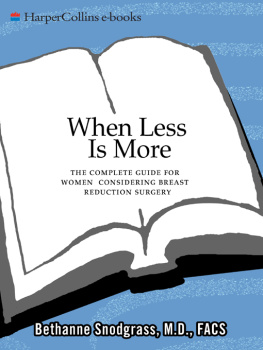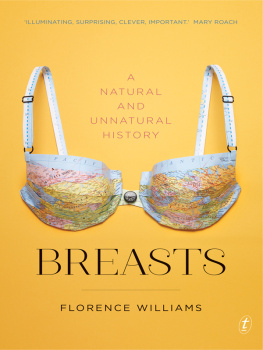An Addicus Nonfiction Book
Copyright 2006 by Alain Polynice, M.D., and Aloysius Smith, M.D. All rights reserved. No part of this publication may be reproduced, stored in a retrieval system, or transmitted in any form or by any means, electronic, mechanical, photocopied, recorded, or otherwise, without the prior written permission of the publisher. For information, write Addicus Books, Inc., P.O. Box 45327, Omaha, Nebraska 68145.
ISBN# 1-886039-17-8
Cover design by Peri Poloni-Gabriel, www.knockoutbooks.com
Interior design by Melissa Marquardt, www.abacusgraphics.com
Illustrations by Jack Kusler
This book is not intended to serve as a substitute for a physician.
Nor is it the authors intent to give medical advice contrary to that of an attending physician.
Library of Congress Cataloging-in-Publication Data
Polynice, Alain, 1965
Your complete guide to breast reduction and breast lifts / Alain Polynice, Aloysius Smith.
p. cm.
Includes index.
ISBN 1-886039-17-8 (alk. paper)
1. Reduction mammaplastyPopular works. 2. BreastSurgeryPopular works. 3. Surgery, PlasticPopular works. I. Smith, Aloysius, 1949- II. Title.
RD539.8.P64 2006
618.190592dc22
2005031976
Addicus Books, Inc.
Addicus Books
P.O. Box 45327
Omaha, NE 68145
Web site: www.AddicusBooks.com
Printed in the United States of America
10 9 8 7 6 5 4 3 2 1
Contents
Index
Introduction
I f you are interested in breast reduction, you are like millions of women who are concerned about the appearance of their breasts. Whether the changes are due to aging, weight gain, weight loss, or childbirth, large breasts can be burdensome, both physically and emotionally.
Breast reductions and breast lifts can be the most challenging procedures in plastic surgery. No two breasts are alike, and achieving symmetry while keeping the scars at a minimum can be difficult. They can also be the most rewarding operations for both the patient and the surgeon. Often breasts cause significant physical pain and discomfort due to sheer size and weight, but even more important are the emotional and psychological effects of women not feeling comfortable in their own bodies. There is no greater reward for the surgeon than having a patient say she has experienced physical relief and now feels more self-confident and more at ease in her own skin.
If you are considering a breast reduction or a breast lift, we hope this book will guide you and provide you with information you need to make the right choice for you.
Acknowledgments
W ithout the love and support of my family, this book would never have become a reality. To my parents for their unwavering faith and encouragement which showed me that nothing was impossible, and to Allison, my wife and colleague, who never lets me sell myself short and allows me to strive for ever-higher goals.
I also owe an immense debt of gratitude to my teachers and mentors for their guidance and to my students for keeping me on my toes. I would also like to thank Alyson Meadows for her editorial help in putting this book together.
Last, but not least, a special thanks to all my patients, for whom this book was written. My greatest satisfaction is being able to provide you with the latest techniques and also use what I learn from you to further advance the field of breast surgery.
Alain Polynice, M.D.
T he techniques used for breast reduction surgery have evolved over many years. We owe a great deal of gratitude to the innovators of the various techniques that have brought us to the to the stage were at today. I wish to thank my mother for setting no limits on achievement. I also wish to thank Dr. William Stahl for defining leadership by example and Dr. John Woods for believing that plastic surgery training was not only for the selected few. I also thank Dr. P. G. Arnold for his friendship and guidance.
Aloysius Smith, M.D.
Where nature finishes producing its shapes, there man begins, with natural things and with the help of nature itself, to create infinite varieties of shapes.
Leonardo da Vinci
CHAPTER ONE

Contemplating Breast Reduction Surgery
Contemplating Breast Reduction Surgery
I f you have large breasts, you are all too familiar with the frustrations that may come with having them. You know what it feels like to have people talking to your chest. Perhaps you avoid days at the beach or pool because you feel self-conscious of your large breasts. Have you ever turned down offers from friends to shop for clothes because of the embarrassment you feel when shirts and dresses dont fit across your chest? Do you turn down the invitation to participate in physical activities?
If you answered yes to these questions, youre not alone. Many women feel restricted by their bodies and actually avoid certain activities that others enjoy because of this discomfort. They dont remember the last time they felt carefree at the beach. They dont even try on sexy lingerie anymore, because they know it wont fit quite right. All of this is because they are not comfortable with their own breasts.
What might life be like without large, heavy breasts? Maybe youd notice people paying attention to you and not just your chest. Maybe youd exercise at the gym without pain. Maybe youd stand taller, because you wouldnt feel self-conscious about your breasts. Theres a good chance that youd notice a difference in the way you feel, the way you move, and how you carry yourself.
How Breasts Develop
Think back to your adolescent years for a moment, back to when it all began. Some girls developed breasts early and some were late bloomers. Either way, it seemed that very few were pleased with the rate of their development. Some girls, embarrassed, changed for gym class in bathrooms down the hall, instead of the locker rooms to hide the fact that their breasts were more fully developed than many of the other girls. Other girls, equally ashamed, tried to hide their underdeveloped breasts and wondered when on earth they would ever catch up to the others.
These girls were simply caught in various stages of breast development. Breast growth is one of the earliest indications that puberty has begun. The process begins with the secretion of hormones from the pituitary gland, at the base of the brain. This gland controls bodily functions such as growth and ovary production. Its common for breasts to begin to grow sometime between the ages of eight and twelve. Whenever the onset of breast development, its likely that breasts will continue to grow for approximately four years after girls begin menstruating.
Breasts develop in five separate stages. The first stage is actually the flat chest that children have before development begins. Stage two begins when children begin to bud, meaning that their breasts form small peaks as nipples swell, and tenderness sets in. The third stage of breast development starts when adolescents begin to build fat in their breast tissue. Breasts grow more rapidly in this stage than in any other. Often, its during this time that girls begin to menstruate. After this point, breast size does not usually increase much; instead, during stage four, the shape of the breasts changes as the nipples begin to protrude. Only during the teenage years will nipples point straight ahead and not sag at all. Stage five is full maturation, and breast development is complete. This entire process should conclude around age seventeen or eighteen. Permanent breast size should be evident at this point.
Next page









